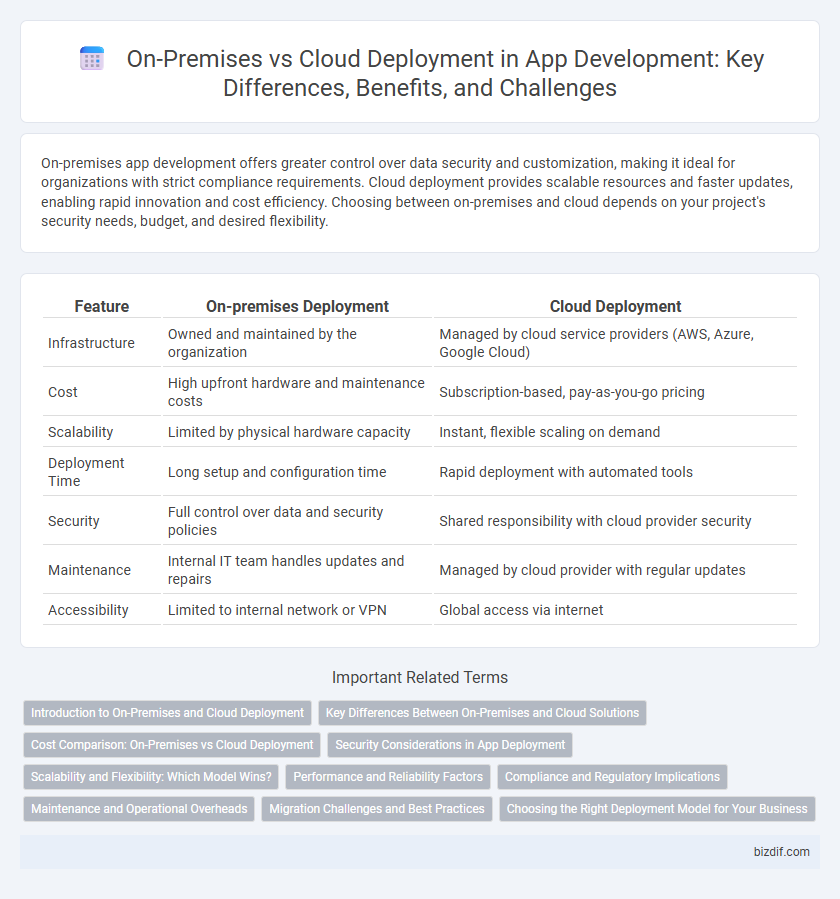On-premises app development offers greater control over data security and customization, making it ideal for organizations with strict compliance requirements. Cloud deployment provides scalable resources and faster updates, enabling rapid innovation and cost efficiency. Choosing between on-premises and cloud depends on your project's security needs, budget, and desired flexibility.
Table of Comparison
| Feature | On-premises Deployment | Cloud Deployment |
|---|---|---|
| Infrastructure | Owned and maintained by the organization | Managed by cloud service providers (AWS, Azure, Google Cloud) |
| Cost | High upfront hardware and maintenance costs | Subscription-based, pay-as-you-go pricing |
| Scalability | Limited by physical hardware capacity | Instant, flexible scaling on demand |
| Deployment Time | Long setup and configuration time | Rapid deployment with automated tools |
| Security | Full control over data and security policies | Shared responsibility with cloud provider security |
| Maintenance | Internal IT team handles updates and repairs | Managed by cloud provider with regular updates |
| Accessibility | Limited to internal network or VPN | Global access via internet |
Introduction to On-Premises and Cloud Deployment
On-premises deployment involves hosting applications on local servers managed by an organization's IT team, ensuring full control over data security and infrastructure. Cloud deployment utilizes remote servers hosted by third-party providers, offering scalability, cost-efficiency, and reduced maintenance efforts. Choosing between on-premises and cloud deployment depends on factors such as data sensitivity, budget constraints, and required flexibility.
Key Differences Between On-Premises and Cloud Solutions
On-premises deployment involves hosting applications and data within a company's own infrastructure, granting full control over security, customization, and compliance. Cloud deployment leverages third-party providers to offer scalable, flexible resources with reduced upfront costs and maintenance responsibilities. Key differences include data ownership, cost structures, scalability options, and the level of IT support required, influencing deployment decisions based on organizational needs and regulatory requirements.
Cost Comparison: On-Premises vs Cloud Deployment
On-premises app development requires significant upfront capital expenditure for hardware, software licenses, and IT staff, leading to higher initial costs. Cloud deployment offers a pay-as-you-go pricing model, reducing upfront expenses and providing scalability that optimizes ongoing operational costs. Total cost of ownership (TCO) analyses often reveal cloud solutions lower long-term expenses due to minimized maintenance, infrastructure upgrades, and energy consumption.
Security Considerations in App Deployment
On-premises app deployment offers greater control over security protocols and data privacy by keeping sensitive information within the organization's physical infrastructure. Cloud deployment utilizes advanced security measures such as encryption, multi-factor authentication, and continuous monitoring to protect data across distributed environments. Evaluating compliance requirements, data sensitivity, and potential vulnerability exposure is critical when choosing between on-premises and cloud security strategies.
Scalability and Flexibility: Which Model Wins?
Cloud deployment offers superior scalability and flexibility by enabling dynamic resource allocation and seamless integration with diverse services, supporting rapid growth and fluctuating workloads efficiently. On-premises solutions, while providing greater control and security, often involve higher upfront costs and limited scalability due to hardware constraints. Enterprises prioritizing agile adaptation and cost-effective scaling typically favor cloud models for app development.
Performance and Reliability Factors
On-premises app deployment offers direct control over hardware resources, often resulting in lower latency and predictable performance due to dedicated infrastructure. Cloud deployment provides scalability and redundancy, enhancing reliability by distributing workloads across multiple data centers and enabling automatic failover. Performance in cloud environments can vary based on network conditions, while on-premises systems maintain consistent performance under stable configurations.
Compliance and Regulatory Implications
On-premises app deployment ensures complete control over data storage and access, facilitating strict adherence to industry-specific compliance standards like GDPR, HIPAA, and SOX. Cloud deployment requires careful evaluation of provider certifications (e.g., ISO 27001, SOC 2) and data residency policies to meet regulatory mandates. Choosing between on-premises and cloud impacts auditability, data sovereignty, and breach notification procedures critical for regulatory compliance.
Maintenance and Operational Overheads
On-premises app development requires dedicated IT staff for continuous hardware maintenance, software updates, and system monitoring, leading to higher operational overheads. Cloud deployment minimizes these responsibilities as the service provider manages infrastructure maintenance, security patches, and scalability, reducing the need for in-house resources. Maintenance costs in cloud environments are typically subscription-based and more predictable, enhancing budgeting accuracy for businesses.
Migration Challenges and Best Practices
On-premises to cloud migration poses challenges such as data security, application compatibility, and downtime management, requiring thorough assessment and strategic planning. Best practices include conducting a comprehensive workload analysis, implementing phased migration to minimize disruptions, and leveraging automated tools for seamless data transfer and validation. Maintaining robust backup protocols and continuous performance monitoring ensures a successful transition and optimal application functionality in the cloud environment.
Choosing the Right Deployment Model for Your Business
Choosing the right deployment model for your app development hinges on factors like data security, scalability, and cost management. On-premises deployment offers enhanced control and compliance for businesses with strict data regulations, while cloud deployment provides flexibility and rapid scalability for dynamic workloads. Evaluating operational requirements, budget constraints, and long-term growth plans ensures an optimal balance between infrastructure investment and performance efficiency.
On-premises vs Cloud deployment Infographic

 bizdif.com
bizdif.com